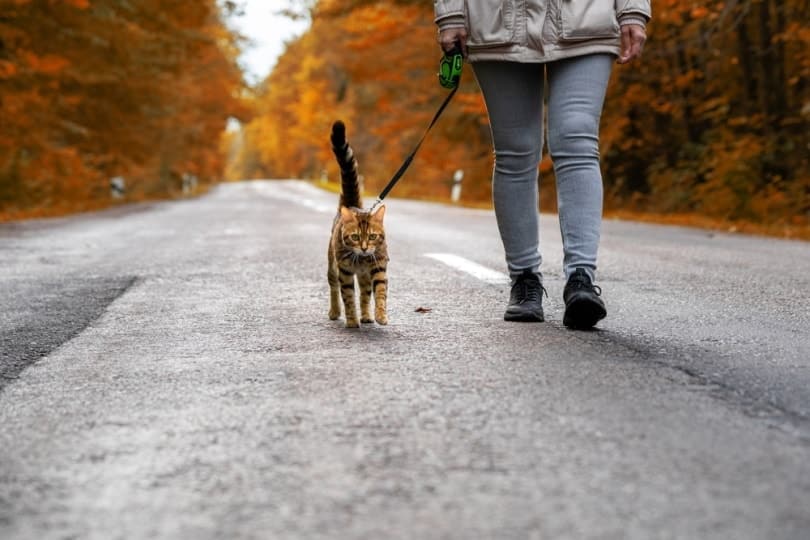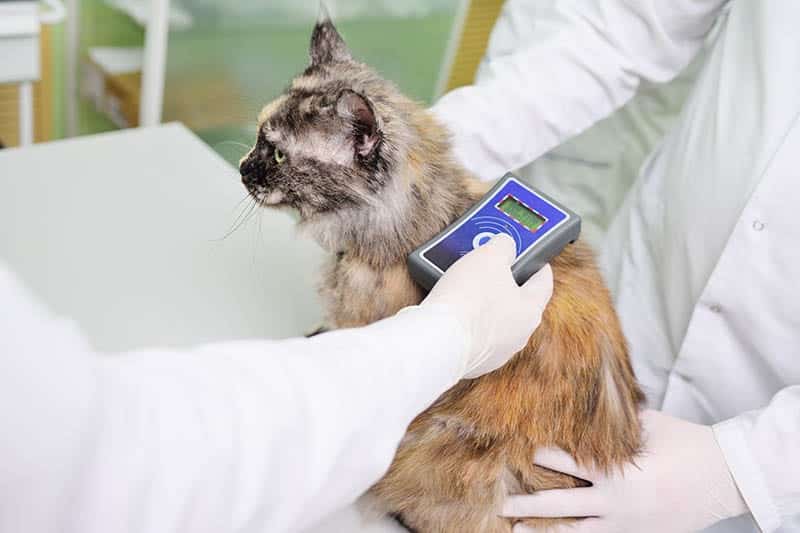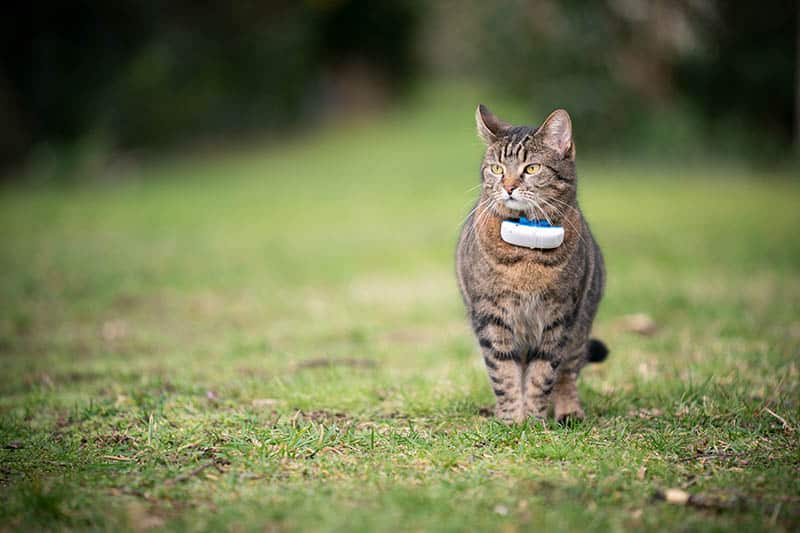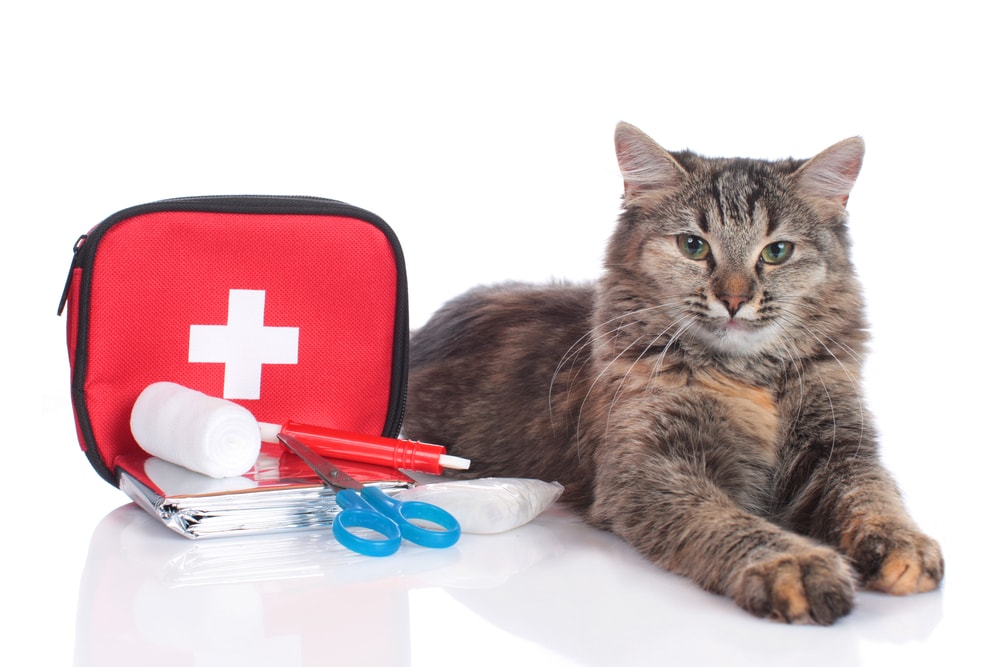The chances are that most of the nearly 32 million pet cats in the United States spend their lives indoors. Statistics show that 68% of Americans don’t give their pets outdoor access compared to 90% of UK residents. The people most likely to let their cats outside are 46 years or older. One way that many may choose to provide welcome mental stimulation for their pets is by hiking with them.
Physical activity is an excellent way to support good health for you and your cat. However, there are several things you should know before you hit the trails to make it a fun and safe experience for both of you.
The 10 Tips on How to Hike With a Cat
1. Additional Vaccinations for Outdoor Cats

All cats should get four core vaccinations, including rabies and feline panleukopenia (FPL). Other non-core options exist for pets at a higher risk of diseases they might get exposed to. If you want to take your kitty hiking with you, we strongly urge you to discuss your pet’s health care needs with your vet, considering their increased risk of exposure by going outdoors.
Other vaccines your vet may recommend include feline leukemia disease complex and feline chlamydiosis.
2. Flea and Tick Preventive—A Must-Have
If your cat goes outside even for short periods, putting your pet on a flea and tick preventative is a no-brainer. It’s not a matter of if your cat will get infected but when. You’re probably going hiking when these pests are most prevalent. Remember that fleas won’t stay on your cat once you get home; they’ll likely infest any place where your pet roams.
Remember that some ticks can carry Lyme disease, making a lack of prevention a serious threat to your family’s health. That’s particularly true if you live in the Northeast or Upper Midwest, which have the highest incidence rates in the country.
3. Leash Up With a Harness

Unless you have a very obedient cat (which is unlikely), you’re better off putting a leash on your cat while on the trail. Something could scare your pet and cause them to run from you. Your path may cross one with a dog that isn’t as fond of felines. Of course, many other things can occur, making securing your cat the safest option.
The best cat leashes are sturdy, comfortable to hold, and easy to attach to the harness. Hepper's Cat Harness & Leash Set offers all that and more, which is why we highly recommend it.
- Escape Proof - Cat leashes and harnesses for walking aren't all equally secure. Our double aluminium...
- Superior Comfort - Our cat harnesses are lightweight, made with premium velvet fabric, breathable...
- Free Extra Strength Leash - You don't need to worry about your cat escaping this harness. This cat...
This set includes a lightweight velvet and mesh harness with reinforced stitching, quick-release buckles, and reflective strips, plus a five-foot leash made from sturdy nylon climbing rope. We especially love this leash's rotating clamp and padded neoprene handle.
At Catster, we’ve admired Hepper for many years and decided to take a controlling ownership interest so that we could benefit from the outstanding designs of this cool cat company!
4. Traveling Carrier
You’ll undoubtedly be transporting your cat to the car in a carrier. You might consider getting a collapsible one that you can tuck inside your backpack for the same reasons we suggest putting your pet on a leash. It’s an excellent way to keep your cat dry in case it rains. If the trail is too busy, at least your kitty will have the security of four walls around them to help relieve their stress.
5. Collar With an ID Tag or Microchipping

The mere thought of anything happening to our precious cats strikes fear in our hearts. It’s one reason we’d never consider taking any pet hiking without some identification, whether it’s an ID tag with contact information or microchipping. If your cat is a friendly animal, someone will likely find them and get in touch with you if the means exist to do so.
6. Smart Planning
Planning your trip is always a smart idea. However, it’s especially important if it’s your cat’s first time on the trail. If possible, opt to hike on a less trafficked path. After all, your pet is going to be on sensory overload with the new experience.
Undoubtedly, your goal is to make it as fun and stress-free as possible. Contact the park you want to visit for suggestions about where to hike.
7. GPS Tracking

If hiking is going to be a regular thing for you and your cat, you might consider getting a GPS tracker for your pet. You’ll have the peace of mind of knowing you can find your feline companion quickly if it should go off the trail. Again, we suggest getting your cat used to wearing the device before heading for the trailhead.
8. Disposable Litter Box
If you’re going out for an extended hike, you’ll find a disposable litter box handy, especially if you plan on camping. It’ll be easier to clean up after your pet. It’ll also minimize the time your cat is roaming through the brush looking for a suitable place to do their business.
9. Keeping Them Cool

It’s imperative to bring along water and a travel bowl for your cat. Your pet is going to get thirsty on the trail, too. Even though felines don’t drink as much as canines, they still need a break every now and then to rest, particularly if the terrain is rough. We also suggest a small tarp for a makeshift lean-to shelter for your pet so that they can get out of the sun if necessary.
10. Practice
It bears repeating to practice at home before going outdoors for your first big adventure. Get your pet used to the harness and leash. You might also consider taking your cat in the car for a few rides so that experience is less traumatic. Then, you can start with a walk on familiar grounds in the neighborhood. This dress rehearsal will help you fine-tune your routine before going to a new place.
Bonus Tip: Bring a First-Aid Kit

While you’re trying to cover all the bases for your pet, don’t forget to take care of yourself. We recommend packing a first-aid kit with medicaments for you and your cat. An over-the-counter antibiotic ointment can take care of minor cuts and abrasions that may occur on the trail. Don’t forget to put a tube of cortisone cream in your bag as well!
Conclusion
Hiking with your cat is a rewarding way to enjoy the outdoors and provide welcome mental stimulation for you and your pet. It’ll also provide an excellent bonding experience while offering a fun way to stay healthy with physical activity. A little preparation and planning before you travel will make your hike a satisfying time for both of you.
Featured Image Credit: Grusho Anna, Shutterstock
Contents
- The 10 Tips on How to Hike With a Cat
- 1. Additional Vaccinations for Outdoor Cats
- 2. Flea and Tick Preventive—A Must-Have
- 3. Leash Up With a Harness
- 4. Traveling Carrier
- 5. Collar With an ID Tag or Microchipping
- 6. Smart Planning
- 7. GPS Tracking
- 8. Disposable Litter Box
- 9. Keeping Them Cool
- 10. Practice
- Bonus Tip: Bring a First-Aid Kit
- Conclusion












